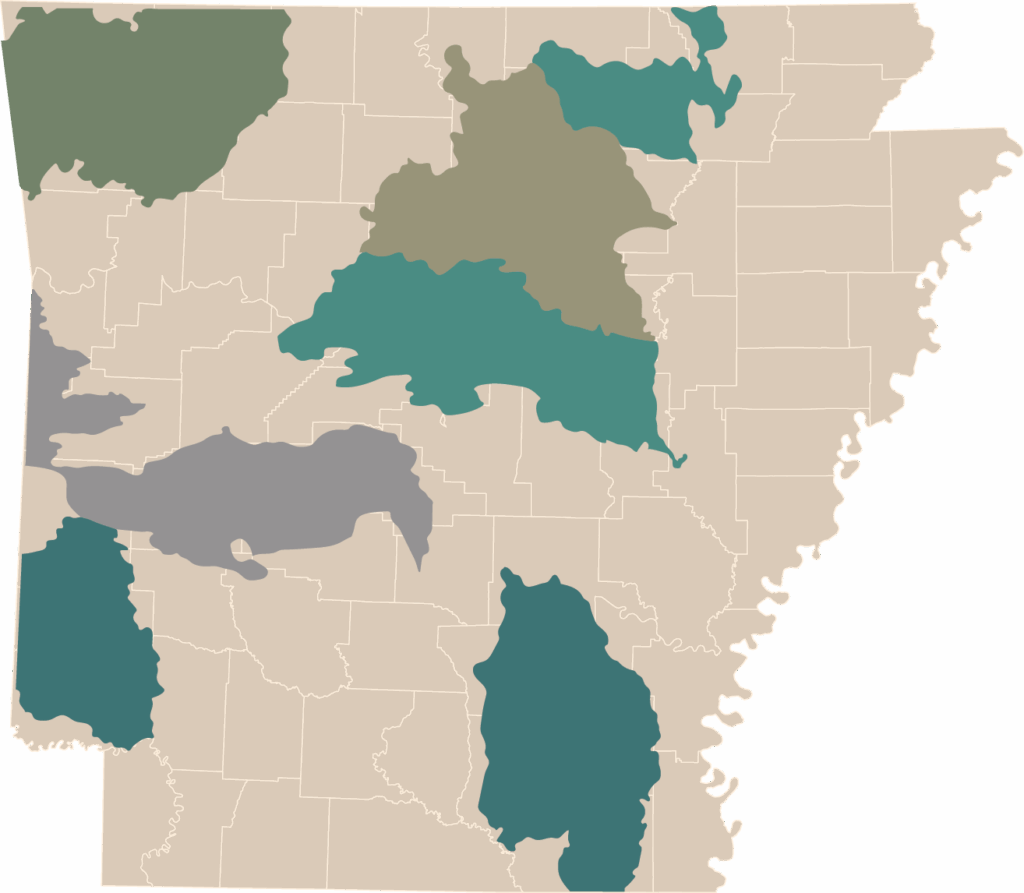Stream Habitat Program

Youth interested in learning more about the ecology and work done to repair waterways across the state are invited to learn more about our Stream Team Program.
Sediment is the number one pollutant in Arkansas and the United States. With over 137,000 miles of flowing water in Arkansas, the number of possible streambanks with erosion problems can cause significant problems to our aquatic resources. The Arkansas Stream Habitat Program assists landowners in developing an appropriate course of action to restore and stabilize eroding streambanks, and will assist with the process of navigating appropriate funding sources and necessary permitting.
Funding for Private Landowners
There are several funding opportunities designed to assist landowners in restoring in-stream habitat and eroding streambanks. We suggest contacting your local Stream Habitat Coordinator and the Natural Resource Conservation Service (NRCS) to determine which is appropriate for you. Here is a short list of some commonly utilized funding sources.
Cash, in-kind services, providing equipment, and/or labor (such as operating equipment, building fence, planting trees, etc.).
Stream Team Program Funds. These funds can be used for any portion of the project. It cannot exceed $5,000 or 25% of the actual total cost of the project, whichever comes first.
Partners for Fish and Wildlife Program. This program is for the enhancement of Threatened and Endangered Species habitats.
Barrier Removals and Aquatic Habitat Restoration. In cooperation with USFWS and NFHP (National Fish Habitat Partnership). Money is funneled through USFWS, checks disbursed by the Arkansas Wildlife Federation.
Cost share through the USFWS for riparian exclusion fencing, water gaps, and alternative livestock watering facilities.
Wetlands & Riparian Zone Tax Credit. Must have prior approval for your project before construction begins to receive tax reimbursements.
Environmental Quality Incentive Program (EQIP). This funding is for streambank stabilization, riparian vegetation establishment, livestock fencing, and livestock watering facilities.
CP22 Riparian Forest Buffer, CP29 Marginal Pastureland Wildlife Habitat Buffer. These practices come with soil rental payments for those who qualify. Basically the – Continuous Conservation Reserve Program or CCRP.
Permitting
Most streambank and instream habitat restoration projects will require several Clean Water Act permits from state and federal agencies. The Arkansas Department of Energy and Environment’s Division of Environmental Quality will review and approve authorization of Section 401 Clean Water Act permits prior to issuance of federal permits and licenses to ensure that proposed projects will not violate state water quality standards. The decision to issue a Section 401 water quality certification rests with the DEQ director and is based on compliance with APC&EC Regulation 2, Establishing Water Quality Standards for Surface Waters of the State of Arkansas.
The United States Army Corp of Engineers (USACE) is responsible for the issuance of 404 Permits. Section 404 of the Clean Water Act established this permitting program to control the discharge of dredged or fill material into waters of the U.S. This also includes utility crossings. This permit is often called a “dredge and fill” permit and it does not absolve the permittee of responsibility towards other regulations. The federal 404 permit states that the permittee must use best management practices to avoid water quality violations. To find out more information, please visit DEQ’s website.
This authorization is required for any instream activities that may violate Arkansas water quality criteria. Obtaining permits is the responsibility of the applicant. The state of Arkansas is divided between three different Corps of Engineers districts:
- Little Rock District is responsible for the southern third of Missouri and most of Arkansas.
- Vicksburg District is responsible for most of southern Arkansas.
- Memphis District is responsible for a portion of eastern Arkansas.
To determine what district you are in, visit the USACE website and click on Arkansas map under Regulatory Boundaries. Then contact the appropriate district via permit manager by state to apply for a permit.

Stream Habitat Coordinators Map
Arkansas is blessed with more than 137,000 miles of streams and rivers, providing high-quality habitat to many species and fresh, clean water to many communities. In addition to picking up litter along shorelines, Stream Habitat Program members help monitor aquatic wildlife populations and plant vegetation along shorelines to prevent erosion and provide valuable habitat.
Tim Burnley, Stream Habitat Supervisor
Tim.Burnley@agfc.ar.gov

Stream Habitat Coordinators Map Legend
Lesley Twiner
Lesley.Twiner@agfc.ar.gov
Garrett Grimes
Garrett.Grimes@agfc.ar.gov
Aaron Norton
Aaron.Norton@agfc.ar.gov
Megan Brandt
Megan.Brandt@agfc.ar.gov
Matthew Irvin
Matthew.Irvin@agfc.ar.gov
Contact
Tim Burnley
Stream Habitat Program Supervisor
